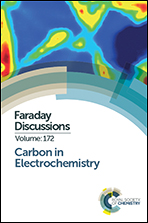Concluding remarks: there's nowt so queer as carbon electrodes
Abstract
This contribution provides a personal overview and summary of Faraday Discussion 172 on “Carbon in Electrochemistry”, covering some of the key points made at the meeting within the broader context of other recent developments on carbon materials for electrochemical applications. Although carbon electrodes have a long history of use in electrochemistry, methods and techniques are only just becoming available that can test long-established models and identify key features for further exploration. This Discussion has highlighted the need for a better understanding of the impact of surface structure, defects, local density of electronic states, and surface functionality and contamination, in order to advance fundamental knowledge of various electrochemical processes and phenomena at carbon electrodes. These developments cut across important materials such as graphene, carbon nanotubes, conducting diamond and high surface area carbon materials. With more detailed pictures of structural and electronic controls of electrochemistry at carbon electrodes (and electrodes generally), will come rational advances in various technological applications, from sensors to energy technology (particularly batteries, supercapacitors and fuel cells), that have been well-illustrated at this Discussion.
- This article is part of the themed collection: Carbon in Electrochemistry

 Please wait while we load your content...
Please wait while we load your content...